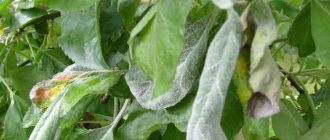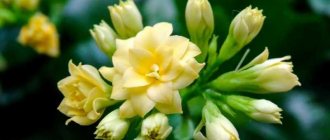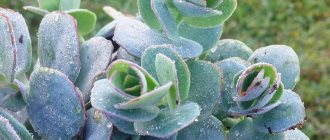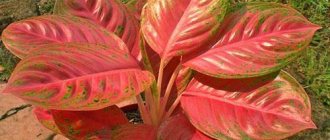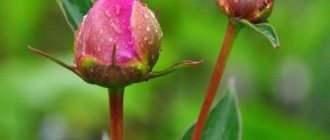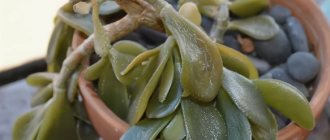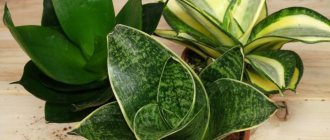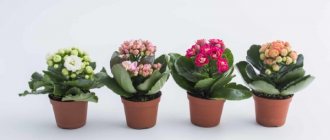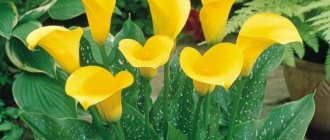Kalanchoe not only acts as a room decoration, but can also help treat many ailments. Unfortunately, sometimes the flower itself needs human help. Diseases can manifest themselves in the form of changes in leaf color, drying out and falling off. There are also pests that attack the plant, sucking the juice out of it. In this article we will look at Kalanchoe diseases, provide photos of them and treatment methods, and also tell you what to do with insect pests.
Main reasons
- Lack of light - the plant stretches upward, and the leaves of Kalanchoe turn yellow or their tips dry out. Just move the plant to a brighter room.
- Stagnant air causes leaves to fall, ventilate the room more often.
Sunburn or severe crowding lead to spots on the leaves. Place the pots at a greater distance from each other and shade them.- Lack of nutrients - stops growth and drops leaves. Replant the plant in new soil and fertilize it.
- An excess of peat or nitrogen in the soil leads to leaf curling. Just replant in new, properly prepared soil.
- Excessive watering or infection with root rot - the leaves become soft and fall off. Reduce watering and treat the root system.
- Excessive direct sunlight leads to complete yellowing of the plant. Rearrange the plant pot or shade it.
- If the Kalanchoe dries out or its leaves wither, it means that there has been no watering for a long time, the composition of the soil is incorrect, or there are pests in it. Water the plant in a timely manner, review the composition of the soil and check for the presence of insects.
You can read more about why Kalanchoe does not bloom here.
Temperature
Kalanchoe grows well at temperatures of 18-22ºС. And if the flower tolerates a slight decrease without harm, then its increase negatively affects the appearance of the plant.
If the air temperature stays around 30ºC for a long time, the leaves of the plant begin to turn yellow and fall off. First, the oldest lower leaves of Kalanchoe dry out and fall off, but if cool weather does not set in, the young leaf blades also begin to yellow.
Kalanchoe grows best in air-conditioned rooms
, where even in the summer heat the air temperature is easy to regulate. If there is no air conditioning in the room, in summer the flower is kept on the north-eastern windowsills, where it is not hot and the sun only appears in the morning.
Diseases and control methods
- Powdery mildew - characteristic white spots with a fungal coating on the leaves. The reason is excessively dry and warm air. Water the plant more often and move it to a cool place. For treatment, spray with fungicides. If you react in time, the plant's health will be restored. Remember that powdery mildew spreads very quickly to other plants. Therefore, act immediately.
- Ring leaf spot - the stem of the plant rots and circular spots appear on the leaves. In this case, the flower begins to die and it is impossible to save it.
- Gray rot - sticky leaves with a gray coating, which later turn into mush. Replace the soil, water regularly, and maintain proper ventilation. For treatment, use fungicides and good temperature conditions.
- Late blight or late blight rot is brown spots or brown coating on the plant. This occurs due to poor ventilation and excess water in the soil. You need to reduce watering, select the right fertilizers, carry out preventive procedures and treat the plant with fungicides.
Reference. The plant is also often subject to stem rot - the trunk or stem turns black. This happens because your plant is frozen. The optimal temperature for the plant in winter is 15°C. It is important to calculate watering at this temperature.
How to treat powdery mildew on Kalanchoe?
The danger of powdery mildew is not only that it can cause the plant to dry out, but also that it is highly contagious. Having appeared on one flower, the mycelium will quickly spread to other plants. This is why the white coating on Kalanchoe leaves needs treatment.
The best way to control powdery mildew is with fungicides. These products quickly remove unaesthetic plaque and also eliminate pathogenic fungi. Fungicides are sold in most specialty stores and, with regular use, quickly help rid Kalanchoe of the existing problem.
Some home remedies also have a good effect in the fight against powdery mildew that has occupied the leaves of Kalanchoe. The simplest recipe consists of soap, water and baking soda. For 4 liters of water, take a spoonful of soda and a few drops of liquid soap. Shake the solution thoroughly before use.
An effective remedy for combating powdery mildew is mustard solution. To prepare it you need only two ingredients: dry mustard (2 l) and boiled water (10 l). Pour mustard into boiling water and mix thoroughly. This solution can be sprayed on the leaves of Kalanchoe, as well as added to it.
Since powdery mildew most often appears on Kalanchoe due to improper care, it is important to adhere to certain rules for caring for this plant. Kalanchoe needs to be watered regularly, preventing the soil from drying out. In addition, if the air in the room is too dry, the plant must also be additionally sprayed. These simple rules are a good way to prevent the occurrence of powdery mildew in Kalanchoe.
White plaque on Kalanchoe: what is it and how to fight it
If a white coating appears on the Kalanchoe, it means that the plant has been affected by the fungal disease “powdery mildew”. It is recommended to treat the flower immediately. The disease can destroy Kalanchoe.
Common Pests
- Aphids are the most dangerous enemy of Kalanchoe.
Appears mainly in spring. If measures are not taken in time, it will spread to neighboring plants. Aphids are small green or black insects that appear on leaves or stems. She takes the sap of the plant and infects it with her poison. Damaged areas are covered with a sticky substance that prevents the plant from breathing. At the initial stage, it is difficult to notice the infection, since the insects are very small and settle on the back of the leaf. It can only be detected due to the unhealthy appearance of the plant. It becomes dirty and deformed. To get rid of aphids, you need to trim off the affected areas and burn them. Treat the remaining plant with an insecticide. Repeat once a week for a month. You can also use green potassium soap: dilute it in water and wash the plant with the solution. Can be replaced with laundry soap. - Multiclawed mites are small glassy mites. When it appears, the leaves and petioles become covered with brown scabs, and the plant tissues harden and become distorted. Wash off the insects with soapy water and treat the plant with an insecticide.
- Scale insects and false scale insects are insects with a two-millimeter body, covered with wax on top. They form a coating (in which sooty fungus is formed) and an accumulation of insects on the plant. The leaves turn yellow, fall off, growth slows down, and flowering stops. For treatment, immediately remove all insects and wash the plant with soapy water. Before removing insects, treat them with alcohol. You can use folk remedies (wipe the plant with a cotton swab and alcohol, use garlic or an old toothbrush).
- Mealybug - an insect that feeds on the sap of Kalanchoe. It propagates the fungus “black mold”. If measures are not taken, the plant will die. The appearance is determined by the appearance of white waxy discharge. For treatment, use mineral oil to spray the leaves.
Incorrect lighting
Kalanchoe requires bright. It requires direct sunlight for 2-3 hours a day. Without this, the stems will begin to stretch and the leaves will shrink.
Why do Kalanchoe leaves dry out? Do not leave the plant in direct sunlight all day.
In this case, yellow spots form on the leaves of Kalanchoe - sunburn.
The burned leaves of Kalanchoe turn yellow and the leaves dry out and then fall off.
To keep the plant green and beautiful, it is kept on eastern windows, where the sun appears only for a few hours. The rest of the time, the flower here is in diffused light, which has a beneficial effect on its growth.
Daylight hours for Kalanchoe should be no more than 10 hours. Therefore, after 2-3 o’clock in the afternoon, it is put away in a closet or covered with a dark cap.
Photo
And this is how leaf diseases and flower pests look in the photo.
Very low air humidity
Kalanchoe is adapted to exist in low humidity. However, very dry air can greatly harm the plant. This is especially dangerous in combination with high temperature conditions. Under such conditions, the leaves turn yellow and dry out, and then fall off.
Most often, plants suffer from dry air during the heating season.
. With proper maintenance in winter, the air temperature for Kalanchoe should be reduced to 15-17ºС.
But if this is not possible and the plant is kept at room temperature, and even near a heating radiator, it may lose most of its leaves, especially from the side of the heating device. To prevent this from happening, in winter you need to keep the flower on the coldest windowsill, away from heating.
Proper care
- Proper watering is to water in small doses, avoiding excess water. Water no more than once every three days and after the soil dries out slightly.
- Spraying is not recommended. The plant does not like high humidity.
- The plant needs to be replanted at least once every two years (read about how to replant Kalanchoe in this article).
Recommendation. Replant by transshipment into identical soil. - Pay sufficient attention to the formation of the bush. Pruning is an integral part of the mandatory care of Kalanchoe (more information about pruning Kalanchoe can be found here).
- The optimal temperature is 15-35°C; at temperatures below plus 5°C it dies.
- Control the lighting - leave it in the sun until noon, then move it to the shade or cover it with a light cloth. In winter you don't have to move it.
- It is advisable to feed with special preparations for succulents or cacti.
Read more about how to care for a Kalanchoe so that it blooms here, and here we talked about how you can achieve abundant flowering after purchase.
This is how you need to care for a Kalanchoe flower at home.
Kalanchoe is a delicate plant that requires your care. If you provide it and pay constant attention to it, then the flower will delight you with its beauty and health.
White plaque on Kalanchoe: what to do
Source: Depositphotos
White plaque indicates the disease “powdery mildew”
Spores of pathogenic fungi are found in the soil and appear only if the rules of plant care are not followed. Fungal disease occurs:
- in case of temperature violation. Cool air and humidity are favorable for the development of spores;
- excess nitrogen in the soil;
- irregular watering. The top layer of soil should dry out slightly before irrigation is carried out. If it dries out or, conversely, does not have time to dry before the next moistening, the fungus becomes active.
The soil in the pot becomes infected by air and through watering if the water is contaminated. The fungus is also transmitted through human hands. Once you touch one plant, do not touch another unless you wash your hands thoroughly.
Feeding errors
Why do Kalanchoe leaves fall off? Often in Kalanchoe, when there is a lack of nutrition, the lower leaves begin to turn yellow and then fall off. It is necessary to feed the plant, because it is planted in soil for succulents, which is usually not rich in humus.
During the growing season, soil depletion soon occurs. And regular but moderate feeding will provide the flower with a decorative appearance and green foliage.
This plant should be fed very carefully. Any excess of nutrients in the soil is just as harmful to the flower as their deficiency.
Fertilizing is carried out only from May to September
. In other months, Kalanchoe is not fertilized.
Kalanchoe is fed 1-2 times a month with liquid fertilizers for succulents. They need to be diluted so that their concentration in water for irrigation is 2 times lower than indicated on the package.
Examples of flower treatment at home
Kalanchoe has medicinal properties and is often used in alternative medicine to treat diseases of the upper respiratory tract, sore throat, inflammation of the adenoids, damage to the upper layers of the epidermis, etc.
Interesting. To treat a runny nose using Kalanchoe, mix the plant juice with water in a 1:1 ratio. This solution is dripped into the nasal passages 3 times a day. Within a few days the runny nose goes away.
For acute respiratory diseases 1 tsp. The juice of the plant is mixed with the same amount of honey. The resulting mass should be eaten 2 times a day.
An alcohol tincture with Kalanchoe juice will help reduce joint pain. To do this, the ingredients are mixed in a 1:1 ratio. The resulting mixture is rubbed on the joints several times a day.
Preparation of tincture with Kalanchoe juice
Why do Kalanchoe leaves wither?
Quite often, flower growers are faced with the following problem: Kalanchoe leaves become soft, wither and soon fall off. There are several reasons for leaf wilting:
- Lack of moisture in the soil;
- Root system rotting;
- A sharp drop in temperature.
Young plants that have not yet accumulated enough water in the above-ground part may drop their leaves when the soil dries out.
The leaf blades become soft, but after watering they are completely restored. It is important to prevent the soil from drying out.
If you still forgot to water the plant, drying out should not be long, otherwise the flower will shed its leaves.
When water stagnates in a pot, root rot occurs - a fungal disease.
. It manifests itself in the withering and falling of the leaves of the plant. Unfortunately, in this case the plant cannot be saved. To prevent root rot, you must strictly adhere to the watering regime.
When the temperature drops sharply, the plant may drop its leaves. It also reacts to a cold draft.
Why do the tips of the leaves turn yellow?
Sometimes only the tips of Kalanchoe leaves turn yellow and dry out. This happens especially often with recently acquired plants. The reason is the changed conditions of existence.
The leaves of the plant are very sensitive to temperature and humidity.
If the temperature in the room is significantly higher than in the garden center where the plant was previously located, then yellowing of the tips of the leaves cannot be avoided.
Decorative Kalanchoes are most often purchased in winter, when they bloom luxuriantly. When entering a heated city apartment, plants react negatively to dry air. The tips of their leaves turn yellow and then dry out. It is advisable to humidify the air near the plant at first.
Diseases
If you grow Kalanchoe, you should be fully aware of what leaf and stem diseases exist and how to properly treat the flower. Now we will describe the main diseases of Kalanchoe and tell you how to cure your home flower.
Late blight
If you notice brown spots on the leaves of Kalanchoe, this is almost certainly late blight. This disease occurs due to improper ventilation or excess water in the soil (so do not flood the plant when watering). When a plant begins to hurt, brown spots first appear on almost every leaf, and gradually the leaves may bend upward and wither. What to do and how to save the flower? An appropriate fungicide, which can be purchased at a specialty store, will help you here. You should also pay attention to the conditions in which the flower is kept and provide the plant with proper care (the correct watering regime and the required amount of fertilizer).
Powdery mildew
White coating on Kalanchoe leaves may be a sign of a disease called powdery mildew. Powdery mildew on Kalanchoe is a common fungal disease that can occur due to excessive dryness of indoor air. The white coating itself, which can be found on Kalanchoe, at first resembles a layer of dust, but over time it thickens and becomes like flour (therefore, the white coating is called mealy).
Due to powdery mildew, the plant sheds its leaves and dies, so the disease must be treated immediately. The main danger of the disease is that it spreads quite quickly to other plants, so it is better to immediately isolate the diseased flower. Treatment is carried out using fungicides.
Gray rot
A dangerous disease due to which Kalanchoe becomes soft, its leaves begin to rot and turn into mush. Gray mold appears on the leaves, and the plant itself quickly begins to die.
The best remedy for this disease is fungicides. It is also worth thinking about how to revive Kalanchoe after the main danger has been eliminated: it is necessary to replace the soil and ensure the correct temperature conditions for your flower.
Stem rot
If you notice that the trunk of the plant has begun to darken and dry out, most likely you are faced with stem rot. First, a small black dot appears on the stem, which then grows into a huge black spot. Why does the trunk begin to turn black and the plant itself wither? A blackened stem can be detected when the temperature drops sharply - for example, in the winter, a flower can freeze and get sick.
How to revive a flower? A folk method that you can use is to wipe off the plaque on the stem, and then disinfect the area with potassium permanganate or ash.
Also try to normalize the temperature so that the plant receives enough heat.
Ring leaf spot
A disease from which it is impossible to save a flower. In this case, the stem also turns black, but this is accompanied by numerous round spots on the leaves of Kalanchoe. It is best to get rid of the infected plant immediately and not try to do anything.

